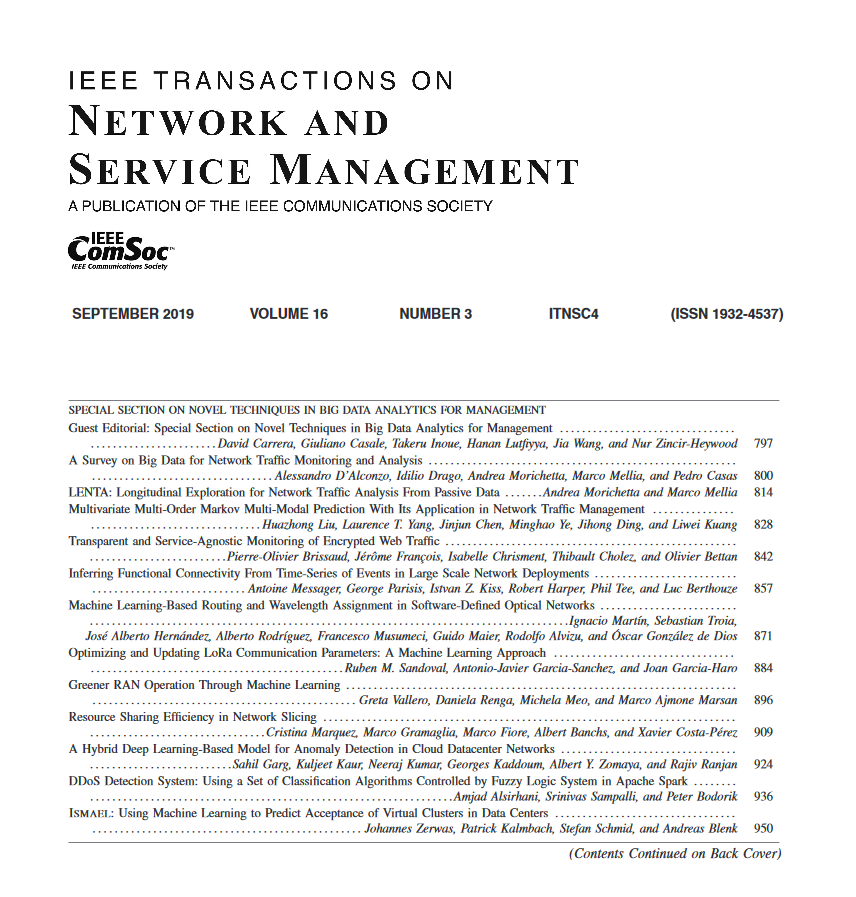使用 ML 框架在 RIS 辅助时变物联网网络中进行 SINR-延迟受限节点定位
IF 5.4
2区 计算机科学
Q1 COMPUTER SCIENCE, INFORMATION SYSTEMS
IEEE Transactions on Network and Service Management
Pub Date : 2025-02-07
DOI:10.1109/TNSM.2025.3539711
引用次数: 0
摘要
时变物联网(IoT)网络中的节点定位是一个关键问题,因为基站(BS)的延迟增加和信噪比(SINR)较差。为了提高接收到的信号强度,最近在发射机和接收机之间使用了可重构智能表面(RIS)。此外,针对RIS和BSs分别提出了新的相位预测方法和最优权重分配框架。然而,由于这些方法采用启发式方法,因此性能较差,导致更多的时间消耗和较差的SINR。在上述挑战的激励下,我们在这项工作中使用机器学习(ML)框架,在ris辅助的时变物联网网络上提出了一种新的节点定位方法。首先,该方法使用coeff2phaseNN计算每个单元对应的RIS上的最优相位配置,该方法已经对发射器,接收器和RIS之间的信道系数进行了训练。随后,使用所提出的VectorSync模型对BS处单个天线单元的重量进行优化。结果证实,与人工神经网络- ris (ANN-RIS)方法相比,coeff2phaseNN方法的总MSE损失减少了89.79%。此外,与ANN-RIS方法相比,该方法与最优相位的绝对RIS相位预测偏差减小了71.04%。此外,与Bartlett和Capon方法相比,所提出的VectorSync方法的最优权值分配时间分别减少了79.28%和92.29%。最后,在时变实验场景下,与传统方法进行了比较,发现该方法的定位误差最小,为6.156%。本文章由计算机程序翻译,如有差异,请以英文原文为准。
SINR-Delay Constrained Node Localization in RIS-Assisted Time-Varying IoT Networks Using ML Frameworks
Node localization in time-varying Internet of Things (IoT) networks is an essential problem due to increased delay and poor Signal-to-Interference plus Noise Ratio (SINR) at the Base Station (BS). To improve the received signal strength at the BS, Reconfigurable Intelligent Surface (RIS) has recently been used between transmitter and receiver. Additionally, novel phase prediction methods and optimal weight assignment frameworks have been proposed over RIS and BSs, respectively. Nevertheless, these methods suffer from poor performance due to their heuristic approach, resulting in more time consumption and poor SINR. Motivated by the aforementioned challenges, we propose a novel node localization method over a RIS-assisted time-varying IoT network using Machine Learning (ML) frameworks in this work. Firstly, the method computes the optimal phase configuration over the RIS corresponding to each element using coeff2phaseNN, which has been trained on channel coefficients among the transmitter, receiver, and RIS. Subsequently, the weight of the individual antenna element at the BS is optimized using the proposed VectorSync model. The results confirm that the coeff2phaseNN method demonstrates a reduction of 89.79% in total MSE loss compared to the Artificial Neural Network-RIS (ANN-RIS) method. Additionally, it demonstrates a 71.04% reduction in the absolute RIS phase prediction deviation from the optimal phase compared to the ANN-RIS method. Moreover, the proposed VectorSync method attains a 79.28% and 92.29% reduction in time required for optimal weight assignment compared to the Bartlett and Capon methods, respectively. Finally, the Localization Error(LR) using the proposed method is compared to conventional methods in a time-varying experimental scenario and found to be the minimum, i.e., 6.156%.
求助全文
通过发布文献求助,成功后即可免费获取论文全文。
去求助
来源期刊

IEEE Transactions on Network and Service Management
Computer Science-Computer Networks and Communications
CiteScore
9.30
自引率
15.10%
发文量
325
期刊介绍:
IEEE Transactions on Network and Service Management will publish (online only) peerreviewed archival quality papers that advance the state-of-the-art and practical applications of network and service management. Theoretical research contributions (presenting new concepts and techniques) and applied contributions (reporting on experiences and experiments with actual systems) will be encouraged. These transactions will focus on the key technical issues related to: Management Models, Architectures and Frameworks; Service Provisioning, Reliability and Quality Assurance; Management Functions; Enabling Technologies; Information and Communication Models; Policies; Applications and Case Studies; Emerging Technologies and Standards.
 求助内容:
求助内容: 应助结果提醒方式:
应助结果提醒方式:


